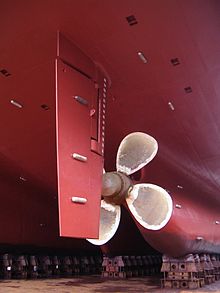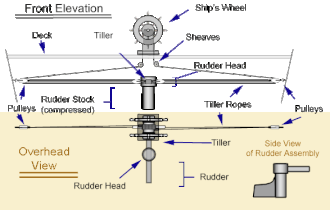Rudder
The rudder is the device of a ship or airplane that is used to change direction by generating torque from the medium flowing around it. This applies to ships (with these the term rudder is also common) with the medium flowing around water and for aircraft or airships with the medium air .
A rudder can only develop a steering effect if the carrying medium (mostly air or water) flows around it as the vehicle moves forward. The steering effect is more pronounced, the more the rudder is turned across to the direction of travel, the larger its effective area and the faster the vehicle moves within the carrier medium (air or water).
term
General language, the term "rudder" is also for locomotion rudder ( belt or skulls a) rowing boat used. In technical terms, however, a rudder always means a rudder. Operating a belt or scull to move a float is also called “rowing” correctly in technical terms. Operating a rudder, on the other hand, is called “steering” or “rowing”.
The somewhat confusing usage of the language stems from the fact that the conceptual distinction between oars and oars is relatively new. Originally, the rudder, also called gubernaculum ("guiding device ") or clavus ("nail") in Latin, was simply a particularly large belt attached to the stern or elsewhere on the ship's wall, and the other belts used for locomotion (lat. remus ), which in principle had the same shape as the rudder used for steering, were not differentiated linguistically. Therefore, “rudder” can still be understood as a collective term for rudder and propulsion rudder (belt) in common usage.
Helmsman is an older term still in use for the officer in charge of a ship's navigational watch . The helmsman, on the other hand, actually controls the ship, usually according to the specifications of the responsible nautical officer (e.g. entries in nautical charts or rudder commands ). The helmsman is always the person who is at the helm at a given point in time, regardless of whether they hold the rank or function of a helmsman. In recreational boating, however, the “helmsman” refers to the helmsman. Neither in commercial shipping nor in recreational shipping is the helmsman necessarily the skipper or captain.
history
The ships in antiquity mostly had two rudders, which were attached aft on each side, the later Viking longships one side rudder. In contrast, the Hanseatic cogs in the Middle Ages had a stern rudder. The first evidence from this period is a wall drawing from the 13th century in the church of Fide (Gotland). The tiller of this rudder, which is much larger there, was moved with the Kolderstock serving as an additional lever . The rudder is still known today in the Steinhuder Torfkahn .
A central stern rudder was already found on the river ships of the Egyptians and Romans . The oldest ship found with a stern rudder is the Bremen Schlachte ship from 1100. Later types of ships then had cable gears that moved the rudder from the steering wheel .
Since the rudder for right-handed operation with a forward view was usually attached to the right-hand side in early sailing ships, the nautical designation starboard resulted for this .
Steering gear
In the case of steering systems of today's modern sea vessels, the desired is the compass heading at the control stand on the bridge in the autopilot input, which operates the rudder. The course of the ship is now permanently compared with the compass position and the rudder blade is adjusted accordingly. This process takes place continuously, so that the steering system is one of the most heavily used devices on a ship. The traditional large steering wheel is only needed for maneuvering if it has not also been replaced by a joystick. A rudder position indicator on the ship's navigating bridge always shows the position of the rudder blade.
There are different types of rudder drives: The so-called rudder quadrant, where the rudder drive is done mechanically via a worm gear , and hydraulic steering machines . The latter work either with exposed hydraulic rams or as so-called rotary vane systems. If the on-board electrical system fails, every steering system can be operated with an emergency setting or an emergency power supply.
Even today, the oar is moved directly with a tiller on boats used in recreational shipping or small fishing boats . The helmsman perceives the forces at the helm more directly. The mechanics of a pure tiller steering is significantly simpler and takes up less space than steering using the steering wheel. The turning movement on the ship's wheel is transmitted to the rudder quadrant (tiller) via ropes or chains and pulleys. The rudder blade is attached directly to the axis of the rudder quadrant (the rudder shaft). The control cables are routed in such a way that turning the wheel to the left (counter-clockwise) changes the course of the boat to port. Boats equipped with a wheel control carry an emergency tiller that can be placed directly on the rudder shaft in the event that the mechanics fail, for example due to a break in the control cables. Double-wheel systems are common on larger sailing boats, with both wheels being mechanically coupled. Because both wheels move synchronously, the helmsman can always steer to windward. In contrast to motor boats, whose steering wheels are similar to those of cars and are predominantly supported hydraulically, the wheels of sailing yachts are still very similar to the historical sailing ship wheels with their large diameters, because servomotors to support the forces are not common due to the power requirement. Autopilots are also not available as standard. Cruising sailors often use mechanical wind vane controls because they do not require electrical energy.
The steering wheel of a sailing ship is not provided with a return spring that automatically moves the rudder back to the center position when the wheel is released. The rudder is required to compensate for the construction- related windwardness of the boat and is therefore not necessarily centered when the boat is going straight ahead. Depending on the shape of the rudder and the balancing (position of the pivot point in relation to the length of the rudder blade), the rudder will go into a stop quite quickly when you let go of the wheel or the tiller and the boat will thus drive an uncontrolled curve. The wheels, on the other hand, are often provided with a locking screw that holds the rudder in its position once the boat is properly trimmed and can keep the ship on course even without an autopilot - provided the wind is constant and the sea is relatively flat.
Since the rudder angle cannot be viewed on its own, the center position is usually marked in color for easier orientation or the ship is provided with a rudder angle indicator.
Types of oars and their parts
The table shows some of the common shapes for ship rudders.
 |
Stern rudder of European sailing ships in the Age of Discovery (so-called hinge rudder ). 1: rudder; 2: upper rudder hinge; 3: lower rudder hinge; 4: stern post; 5: planks |
 |
Fixed rudder on the keel of a steamship |
 |
Balance rudder on a motor ship. About 1/4 of the rudder surface is in front of the axle. A balance rudder does not normally move by itself even if the steering wheel is released. The rudder is flowed directly from the propeller for optimal maneuverability. |
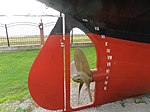 |
Skegruder. The skeg (rudder fin) serves as an attachment point. |
 |
Combined rudder and hydroplanes of a submarine , the axis of the inflowing propeller is aligned with the intersection of the two respective pair of rudders. |
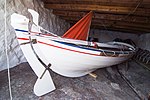 |
Fixed rudder at the stern (conventional shape) |
 |
Lower rudder of a dinghy. This is attached to the stern and can be picked up if necessary, for example to go to the beach without damaging the rudder. 1: tiller; 2: tiller extension; 3: rudder stock; 4: pick-up line; 5: rudder blade; 6: lowering line |
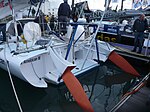 |
Double steering system of a racing sailing yacht. By using two inclined rudder blades, the flow is optimized when heeling on the lower blade. The upper one comes from the water |
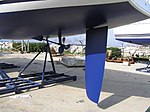 |
Free-standing, pre-balanced spade rudder of a modern cruising sailing yacht. The rudder of a sailing yacht is comparatively deep and extensive because there is no direct flow through the propeller. Even when heeling, the rudder must remain in the water and must not get caught in the turbulence of the hull in order to avoid a stall and thus an undesirable sun shot . |
Special designs:
- Active rudder : A rudder with an integrated (small) propeller that helps the ship to pivot at low speed
- Becker rudder , also Becker flap rudder: The rudder has a fin at the rear end that reinforces the deflection when the rudder is laid.
- Costa pear ( spade rudder): A horizontal drop-shaped thickening of the rudder in the propeller jet.
- Semi-balanced rudder : the upper forward edge of the rudder is provided as a skeg ( Skeg connected) rigidly connected to the hull, the rudder is supported with a bearing and does not rotate with. Advantage: the rudder is also stored in its center. Bending moments from transverse loads on the rudder blade (lift forces) do not have to be absorbed by the rudder stem. Disadvantage: when the rudder is in place, the configuration is very rugged, which can lead to cavitation problems. In addition, operational strength problems (fatigue cracks up to the loss of half the rudder blade) may occur in the hollow corners of the rudder blade.
- Schilling rudder : The rudder does not have a conventional teardrop-shaped profile, but a cut back with two sharp tear-off edges.
- Spade rudder: The entire rudder can be rotated as a trapezoidal fin and is only mounted inside the fuselage.
- Balance rudder: The pivot point of the rudder is not on the leading edge of the rudder, but a little behind it. This reduces the effort required to put the rudder, because part of the current acts in the direction of the rudder position.
- Twisted Spade Rudder : The upper and lower halves of the leading edge are twisted against each other in order to adapt to the twist in the propeller jet. The intention is to reduce energy losses when driving straight ahead, not a better rudder effect.
- Ruddy : The rudder blade is located in the bow , for example when barges .
- X-rudder : It consists of four diagonally arranged rudder blades on the stern of a submarine
A transverse thruster (literally not a rudder) is a device used for better maneuvering to move the forward or rear end of the ship to the side.
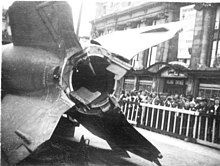
Aerospace
In the case of aircraft , too, the control systems are referred to as rudders . The movable rudders together with the rigid fins form the tail unit for flight control of the aircraft:
- the elevator for attitude control around the transverse axis,
- the rudder for attitude control around the (vertical) axis,
- the aileron on the trailing edge of the wing tips for attitude control around the longitudinal axis.
Within the earth's atmosphere, the same rudder principle can be used for rockets as for airplanes; in addition, guide surfaces in the exhaust jet can exert corresponding lateral steering forces by deflecting the exhaust jet.
literature
- Olaf Höckmann: Ancient seafaring. CH Beck, Munich 2001. ISBN 3-406-30463-X
- Lawrence V. Mott: The Development of the Rudder, AD 100-1600. A Technological Tale. (PDF; 25.2 MB) Thesis. Texas A&M University, May 1991.
- Rudder , technical details including how a Jenckel rudder works. On universallexikon.deacademic.com
- Schiffs-Modell magazine No. 9/2012; contains, among other things, a chapter on the Jenckel rudder; Neckar publishing house
Web links
Individual evidence
- ↑ tungsten to moon field: Wiking ride. 1. Cultural travel guide Denmark, Norway, Northern Germany. Bastei-Lübbe, 1988, ISBN 3-404-60212-9 , p. 86.
- ↑ Henry Winter: The tiller in "The yacht", Year: 1937, Issue: 18 ( Memento of 28 December 2014 Internet Archive ), accessed on 28 December 2014
- ↑ Manfred Rech: The Bremer Schlachte-Schiff: A proto-cog with stern rudder from around 1100. (Writings of the German Maritime Museum, Vol. 76.) Bremerhaven / Wiefelstede 2015.
- ↑ Joachim Schult: Segler-Lexikon. Delius Klasing, Bielefeld 2008, ISBN 978-3-7688-1041-8 , keywords rudder quadrant and rudder stock
- ↑ Helge Janßen : Sailed enough? Drive a motorboat! BOD, S. 63 f . ( Preview in Google Book Search).
- ^ Designations according to seamanship. Yachting manual. 28th edition, Delius Klasing, Bielefeld 2008, ISBN 978-3-7688-0523-0 , p. 39.
- ↑ https://img.nauticexpo.de/images_ne/photo-g/30793-9516595.jpg Picture of a flap rudder
